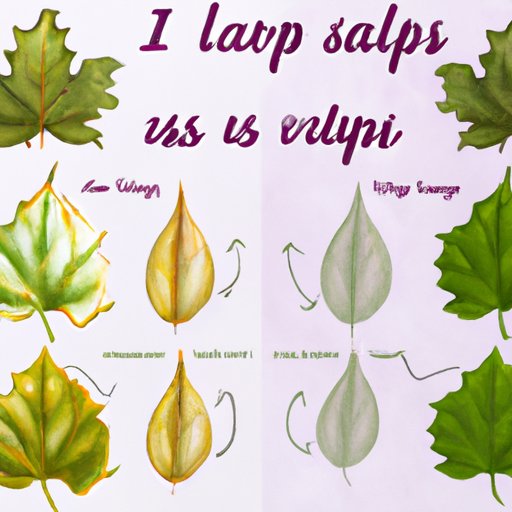
The Art of Drawing a Leaf: A Step-by-Step Tutorial
Have you ever looked at a leaf and wondered how to draw it? Well, wonder no more! In this article, we will provide a detailed tutorial on how to draw a leaf. Whether you are a beginner or an experienced artist, this guide will offer tips and techniques to help you create your own beautiful leaf drawings.
Step-by-Step Tutorial
To start drawing a leaf, begin by sketching its basic outline using light pencil lines. It doesn’t have to be perfect at this stage, so don’t worry if it’s not quite what you want yet. Once you’re satisfied with the outline, you can start adding in more specific details of the leaf shape.
Next, add details to the leaf. This includes the veins and any texture or patterns that are on the leaf. Be sure to take your time with this step, as it can make all the difference in the final result.
Once you are happy with your outline and details, it’s time to move on to shading. This will help add depth and dimension to your leaf drawing. Start by shading the darkest areas first, then work your way towards the lighter areas, paying close attention to the way the light hits the leaf.
Finally, add any finishing touches that you feel are necessary to complete your leaf drawing. This may include adding some highlights or additional details to really make your leaf pop!
Types of Leaves
Did you know that there are many types of leaves that you can draw? Each type has its own unique features and characteristics that can make your drawing truly stand out. Let’s take a look at some of the most popular types of leaves:
- Oak Leaves: Oak leaves have a distinctive lobed shape with pointy tips. They are typically drawn with deep grooves and veins.
- Maple Leaves: Maple leaves are known for their intricate shapes and vibrant colors. They have deeply serrated edges and veins that run throughout the leaf.
- Palm Leaves: Palm leaves have long, wide fronds that taper off to a pointed tip. They are typically drawn with a lot of detail and texture.
- Rose Leaves: Rose leaves are small and delicate, with a distinctive heart shape. They are typically drawn with smooth curves and sharp edges.
Once you’ve selected the type of leaf you want to draw, be sure to research its specific characteristics to make your drawing as accurate and realistic as possible.
Different Mediums
There are many different mediums available for leaf drawing, and each one offers its own unique advantages and challenges. Some popular mediums to consider include:
- Pencil: Pencils are a versatile and affordable option for drawing leaves. They allow for precise control and can be used for shading and detail work.
- Pen: Pens offer a bolder and more graphic look than pencils. They can be used to create sharp, clean lines and are ideal for stylized drawings.
- Marker: Markers are great for adding pops of color to your leaf drawing. They can be used alone or in conjunction with other mediums to create depth and texture.
- Watercolor: Watercolors offer a soft and dreamy look to leaf drawings. They require a bit more skill and practice to use effectively, but can produce stunning results.
Be sure to experiment with different mediums to find the one that works best for you and your leaf drawing style.
Tips and Tricks
Drawing leaves may seem simple, but there are many ways to add depth and detail to your drawings. Here are some tips and tricks to take your leaf drawings to the next level:
- Use a range of pencils: Using a range of pencils of different hardness can help you achieve a wider range of shades and textures in your drawing.
- Take breaks: It’s important to take breaks while drawing to prevent eye strain and ensure that your hand is steady.
- Study real leaves: Observing real leaves can help you understand their unique characteristics and translate that into your drawings.
- Use reference images: You don’t have to draw from real leaves. Reference images can help you draw unique and stylized leaves with ease.
- Experiment with texture: Adding texture to your drawing can give it a more realistic and organic look. This can be achieved through crosshatching, stippling, or other techniques.
Realistic vs. Stylized
Deciding whether to draw a realistic or stylized leaf can be a matter of personal preference. Realistic drawings seek to capture the true essence of the leaf and can be extremely detailed and intricate. Stylized drawings, on the other hand, simplify the leaf’s shape and patterns, resulting in a more whimsical and graphic look. Here are some tips to help you decide which style is best for your drawing:
- Consider the purpose of the drawing: If you’re drawing for a scientific or educational purpose, a realistic drawing may be more appropriate. If you’re drawing for personal or creative purposes, a stylized drawing may be a better fit.
- Experiment with styles: Don’t be afraid to try both realistic and stylized drawing to see which one suits you best.
- Find inspiration: Look to other artists or even nature itself for inspiration on how to draw leaves in different styles.
Conclusion
Now that you’ve learned the step-by-step process of drawing a leaf, as well as some tips and tricks to take your drawings to the next level, it’s time to put your skills to the test. Remember to experiment with different types of leaves, mediums, and styles to find what works best for you.




